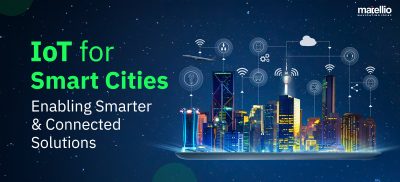
The Internet of things is considered the game changer for many industries. Whether healthcare, education, fitness, law, or home automation, IoT has penetrated every field. Then how can agriculture stay behind?
IoT is playing a significant role in this stream. It can be witnessed that the agriculture industry is adopting different technologies. These technologies are focusing on offering a promising future to farming. Internet is controlling various major activities within the field of agriculture through IoT. The smart irrigation system is one of the best examples showcasing the use of IoT in agriculture.
Even the market trends support the growth in adopting the Internet of things (IoT) in agriculture. As per the market research, the smart irrigation market driven by IoT was valued at $1,404.4 million in 2021. This value is anticipated to grow at a CAGR of 13.8% between 2022 and 2030. The adoption of IoT-driven tools in an irrigation system is due to digitalization and extreme weather conditions. (Source)
In this post, we have mentioned significant aspects connected with smart irrigation systems for your knowledge.
What is Smart Irrigation System?
It cannot be denied that irrigation is one of the most tiring yet significant tasks that farmers have to perform with perfection. The crop type, weather, soil texture, water availability, and many other elements must be considered to fulfill this process. Anything goes wrong with the irrigation process, and the entire crop quality can drop.
With the IoT-based smart irrigation system, sensors and controllers are being used to check the soil’s moisture level. The moisture level can be detected beyond the threshold, and the pumps can be turned off automatically if the water requirement is over.
IoT is also used to sense the presence of rain; it helps the farmers to keep a check on the weather so that the pumps can be stopped if it starts to rain. There are multiple perks to this technology-laced irrigation system.
Benefits of Smart Irrigation System

We have mentioned earlier that the future of IoT in agriculture is bright as this technology is being adopted widely on the global level. After learning about the increasing market trends, it is necessary that we let you learn about the perks that IoT has added to the irrigation system and made it smart. A few major perks are:
1. Reduces the Wastage of Water
By adopting smart irrigation techniques, you can save water by reducing its overuse. When added to your irrigation system, the IoT-driven controllers can adjust the watering as needed. The sensor can detect the weather, and then the controller knows exactly when the water will be required and when to stop.
The water will be delivered as per the soil type and plant type. The smart controllers even have a micro-climate setting that can be adjusted as per the property location to reduce the risk of overwatering.
Isn’t it the best way to save water for today? Saving water is to save the future. Along with the global warming issue, reducing the pure water level is also a global crisis. A smart irrigation system can contribute to conserving water resources.
2. Reduces the Hardscape Loss
One major issue faced in the agricultural process is the loss of hardscape due to over-watering the landscape. The area that is considered as the non-living part of the landscape, which means they are not used for growing crops and includes a patio, pathways, etc. is known as Hardscape. With the irrigation system, which is smart, the watering areas can be selected. The areas with no plants will not be damaged due to watering. These latest technologies added to your irrigation system will save the hardscape from cracking due to the irrigation process.
3. Enhances the Beauty and Health of the Landscape
The major concern of the people wanting to switch from the traditional irrigation system to this smart one is the health of their landscape. People think that changing the irrigation system might harm the quality of their land or reduce its fertility. But let us tell you by adopting the IoT smart irrigation system; they will improve the health of their landscape.
Overwatering is one of the major reasons that lead to the deteriorating health of the landscape. With the IoT sensors and controllers, the irrigation system is adjusted as per the requirement. No overwatering is allowed, which keeps the land healthy and fertile for the crops. The soil type, weather, plant types, and many other crucial elements related to irrigation can be understood well using IoT tools.
4. User-Friendly
The irrigation system laced with IoT technologies is easy to learn and use. There is no need for hard training to understand the working of these tools. It easily allows you to adjust the water flow as per your landscape requirement. If your region has any government restrictions or limitations on the water, the tool can easily be adjusted accordingly, making the entire irrigation process comfortable for you. The application of a smart irrigation system can be processed automatically, so the operator’s labor is reduced.
Features of Smart Irrigation System

The latest effective processes advanced due to the technology of IoT have evolved certain traditional techniques used within agriculture. Undoubtedly IoT development services adopted by the agriculture industry have done wonders for them. The automated irrigation system is the best example for supporting the above statement.
Using these tools enables control of the water flow into the land and contributes to resolving the global issue of water by reducing its wastage. But what is within these irrigation systems that makes them stand out? We will share this answer by discussing a few major features integrated within these irrigation systems.
1. Quick and Easy Installation
One of the best features of the smart irrigation system is the ease it offers its users. It is laced with the latest technologies but is very easy to install. The process does not require rocket-science knowledge or much of your time during installation. The components have clear labels with an advanced design that can be understood quickly. You may buy the system, or you might choose to hire IoT developers to design the system as per your need. In any of the scenarios, the feature of easy installation can be bagged.
2. Unique Water Schedules
You know about one of the major advantages of a smart irrigation system is to saves water and offers the perfect flow per the requirement. It is possible due to designing a unique water scheduling within the system. The automated irrigation system allows for customizing the watering schedules; even the sprinkler systems can be customized. The timing to water the crops can be set as per your requirement. With this system, you get overall control of the irrigation methods.
3. Set the Use of Water Efficiently
This feature is similar to the one we mentioned above, but it is focused on the usage of water within the IoT based smart irrigation system. The top reason to adopt this evolved form of irrigation is that it allows the conservation of water resources by using less water for agricultural activities, specifically irrigation. With the help of the water setting, larger droplets are produced to be sprayed over the crops. It reduces the amount of water used overall.
4. Controlled Through Mobile Application
Lastly, a mobile application can control the smartness added to the irrigation system. The applications are connected to sensors and controllers and can be accessed on smartphones or other devices. You can easily track your water schedule, consumption, and other things related to your irrigation process without hassle. Any requirement for your irrigation process can be monitored, and you can track them in real-time.
IoT Based Smart Irrigation System: Controllers and Sensors
There are places where the agriculture industry suffers due to the poor irrigation system. You will not deny that the quality of rainfall impacts the quality of the landscape. Under or over-irrigating can lead to wastage of water and decrease soil fertility. It is why the smart irrigation systems market is expanding. People at the global level accept that using technology would help the agricultural sector to boom in the future, and IoT contributes to this belief.
Two major assets that are being used within the automated irrigation system driven by the Internet of things are controllers and sensors. These two are the major elements with which the functioning of this evolved irrigation system is possible. The benefits and features you read above are all connected to these two technologies. Here we will discuss the controllers and sensors and brief you about their functioning.
1. Controllers
Controllers are one of the crucial pillars of the smart irrigation system. It is used as the irrigation timer to schedule the water flow as per the requirement. Not just this, but different controller types are used to fulfill various demands smartly.
a. Climate-Based Controller
It is the type of controller called an evapotranspiration controller (ET). It detects the local weather data and schedules the irrigation process accordingly. This system is the combination of the transpiration process by plant materials and evaporation from the soil surface.
There are multiple enterprise solutions that businesses acquire to enhance their growth. Similarly, adopting climate-based controllers within your irrigation system can be best for the automated process. It is efficient for the users to adjust their irrigation plans as per their climatic conditions. There are different types of ET controllers:
- Signal based controllers,
- On-site weather measurement controllers,
- Historic ET controllers.
b. Soil Moisture Sensor Controllers
The soil moisture sensor controllers are the second type of controller used within these automated irrigation systems. It is the type that does not use weather data, but rather detects the soil moisture sensor in the root zone of the landscape. The water requirement for the ground can easily be detected through this system.
Through these controllers, the soil volumetric water content can be estimated according to which the controllers open the valves, and the irrigation process is started. These controllers are used to reduce water wastage and also maintain turfgrass quality.
2. Sensors
After reading about the controllers, you would want to hire a dedicated developer and get an irrigation system as per your requirement. But is it enough? No, to make your irrigation system smart, you need to upgrade the functionalities of controllers by pairing them with the sensors. It can increase the overall efficiency of your irrigation system. There are different types of sensors as well:
a. Soil Moisture Sensor
This type of sensor can be connected to your controller and measure the soil moisture. It can help detect the land’s moisture deep in the root zone. After learning about the moisture content, the controllers can be signaled to schedule the water flow for irrigation. These sensors can be customized as per the user’s requirement for their smart irrigation system.
b. Rain and Freeze Sensor
Another sensor type is a rain and freeze sensor used to save water. Watering the crops during the rain can be wasting the water. But it is hard to know about the weather conditions and set the irrigation process. Well, it can be easy with these sensors as they can detect the weather, and your irrigation process can be planned accordingly.
Conclusion
This blog would have helped you draw a clear sketch discussing the working of smart irrigation systems and the important concepts related to the same. You would agree that the future of agriculture will rely on data collection and analysis using the latest technological solutions. IoT in agriculture is adding endless possibilities to this sector and can evolve your business. All you need to do is understand its use and your needs properly so that you can avail the relevant services from the best. One of the major aspects of developing the automated irrigation system is to have budget clarity. When choosing the best developers, you get the proper smart irrigation system cost estimation per your project requirement.



